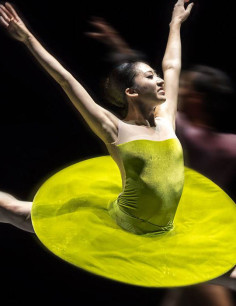UNE SOIRÉE AVEC FORSYTHE
The Vertiginous Thrill of Exactitude

source:sortiestheatreauvergnefr
Dirigée depuis 2011 par José Carlos Martinez, danseur étoile venu du Ballet de l’Opéra de Paris, la Compañía Nacional de Danza d’Espagne a trouvé à l’évidence un nouvel élan. Naviguant entre grands classiques et écritures plus contemporaines, la troupe arrive pour la première fois à Clermont-Ferrand avec un fastueux programme William Forsythe. The Vertiginous Thrill of Exactitude sur le final de la 9e Symphonie de Franz Schubert joue ainsi de la pure technique classique pour explorer d’autres champs chorégraphiques. Ici les solos comme les pas de deux semblent repousser les limites de la virtuosité. Artifact Suite est un travail de précision inouï tant sur les lumières, le découpage de l’espace ou l’agencement du corps de ballet, un précipité chorégraphique entre vertige et poésie sur la musique de Jean-Sébastien Bach. Cette soirée Forsythe enfin se clôt par Enemy in the Figure. Autant dire un feu d’artifices en mouvement. Ballet noir et blanc où les silhouettes des interprètes se découpent sur un décor ondulé, c’est un Forsythe qui se gorge de tours et de pirouettes, de courses et de pliés. Sur une composition du fidèle Thom Willems, les danseurs semblent engagés dans une course poursuite avec leur ombre. William Forsythe dans cette pièce de 1990 – composante du ballet Limb’s Theorem – imposait sa vision du ballet comme débarrassé du poids de l’histoire. Depuis, Enemy in the Figure est considéré comme un chef-d’œuvre. Il l’est toujours. La Compañia Nacional de Danza en apporte à son tour la preuve.
.
.
.
.
.
.
.
source:bachtrackcom
The Vertiginous Thrill of Forsythe is an evening of three works by acclaimed choreographer William Forsythe – The Vertiginous Thrill of Exactitude, New Suite and In The Middle Somewhat Elevated. Dance and dancers are the protagonists of these works in which the dancers of the Pacific Northwest Ballet revealed a new side of themselves and added another facet to the company’s artistry.
From the first notes of Schubert’s fast-paced Symphony no. 9, The Vertiginous Thrill of Exactitude leaves no moment to contemplate. Classical ballet is stripped to elemental form and void of dramatic narrative; even the womens’ tutus have become mere references of themselves in the shape of lime green discs. Two men and three women speed through intricate phrases in solo variations and pas, including a pas de cinq, which twists and torques classical technique to new physical possibilities. We race along with them, counting the music and the steps and at times having to remind ourselves to breathe. The piece becomes an experience of the performance from the dancers’ perspective, and of the immense physical exertion in search of heightened artistic expression. The dancers’ occasional struggles with stamina detracted at times from the overall pace, but were masked by earnest efforts and broad smiles. Carrie Imler and Jonathan Porretta stood out for their clean execution and brought ferocity to the piece. As brusquely as it began, it finished with the five dancers posing abruptly in some kind of épaulement to the audience; both sides spent and exhilarated.
Each of the nine pas de deux that make New Suite seemed like a destined pairing. The clear relationship and unique chemistry in each of the pairs brought commendable honesty to each duet. Notable were Laura Tisserand and Karel Cruz who danced to Gavin Byars’ String Quartet no. 1. They were dressed in silvery white, Tisserand with a small disc-shaped tutu reminiscent of those in Vertiginous, but with no further similarity otherwise. Their moments of tension and release evoked contrasting emotions of fragility and strength, which shifted alternatively – and fluidly between them. Delicate notes of the solo violin seemed to follow their every move, making it clear that the dancers, not the music, led the way.
In The Middle, Somewhat Elevated portrays the habitual exercises of ballet company dancers against a track of sharp, industrial sounds by composer Thom Willems, and invites us to the grittier side of company life behind the veneer. The stage was a black cavern lit by sharp overhead lighting with its side wings drawn open to expose the mechanical pulley systems – its inner workings. The sole decoration, a pair of golden cherries positioned above the stage, has been said to give the piece its title. Originally created for the Paris Opera Ballet in 1987, In the Middle has become a staple ( or challenge) in the repertoire of many companies, each iteration made more exciting by personalities that shape the piece as they perform it.
.
.
.
.
.
.
.
source:

